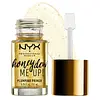What's inside
What's inside
 Key Ingredients
Key Ingredients

 Benefits
Benefits

 Concerns
Concerns

No concerns
 Ingredients Side-by-side
Ingredients Side-by-side

Water
Skin ConditioningGlycerin
HumectantAlcohol Denat.
AntimicrobialBetaine
HumectantHoney Extract
HumectantCollagen Extract
Skin ConditioningPortulaca Oleracea Extract
Skin ConditioningHyaluronic Acid
HumectantBifida Ferment Lysate
Skin ConditioningNelumbo Nucifera Flower Extract
Skin ConditioningJasminum Officinale Flower Extract
MaskingLavandula Angustifolia Flower Extract
CleansingRosa Centifolia Flower Extract
AstringentLilium Tigrinum Flower/Leaf/Stem Extract
Skin ConditioningIris Ensata Extract
Skin ConditioningHibiscus Sabdariffa Flower Extract
Skin ConditioningAnthemis Nobilis Flower Extract
MaskingAllantoin
Skin ConditioningCaprylyl Glycol
EmollientPEG-40 Hydrogenated Castor Oil
EmulsifyingCarbomer
Emulsion StabilisingSodium Polyacrylate
Absorbent1,2-Hexanediol
Skin ConditioningPhenoxyethanol
PreservativePotassium Hydroxide
BufferingPanthenol
Skin ConditioningBenzophenone-5
UV AbsorberDisodium EDTA
Citronellol
PerfumingLimonene
PerfumingGeraniol
PerfumingParfum
MaskingCI 77480
Cosmetic ColorantCI 15985
Cosmetic ColorantCI 19140
Cosmetic ColorantWater, Glycerin, Alcohol Denat., Betaine, Honey Extract, Collagen Extract, Portulaca Oleracea Extract, Hyaluronic Acid, Bifida Ferment Lysate, Nelumbo Nucifera Flower Extract, Jasminum Officinale Flower Extract, Lavandula Angustifolia Flower Extract, Rosa Centifolia Flower Extract, Lilium Tigrinum Flower/Leaf/Stem Extract, Iris Ensata Extract, Hibiscus Sabdariffa Flower Extract, Anthemis Nobilis Flower Extract, Allantoin, Caprylyl Glycol, PEG-40 Hydrogenated Castor Oil, Carbomer, Sodium Polyacrylate, 1,2-Hexanediol, Phenoxyethanol, Potassium Hydroxide, Panthenol, Benzophenone-5, Disodium EDTA, Citronellol, Limonene, Geraniol, Parfum, CI 77480, CI 15985, CI 19140
Water
Skin ConditioningGlycerin
HumectantButylene Glycol
HumectantGlycereth-26
Humectant1,2-Hexanediol
Skin ConditioningNiacinamide
SmoothingCamellia Sinensis Seed Oil
HumectantMethylpropanediol
SolventPanthenol
Skin ConditioningChlorella Vulgaris Extract
Skin ConditioningGlucose
HumectantAcrylates/C10-30 Alkyl Acrylate Crosspolymer
Emulsion StabilisingFructooligosaccharides
HumectantFructose
HumectantHydrogenated Lecithin
EmulsifyingSodium Polyacryloyldimethyl Taurate
Emulsion StabilisingYeast Ferment Extract
Skin ConditioningTromethamine
BufferingDipotassium Glycyrrhizate
HumectantEthylhexylglycerin
Skin ConditioningSodium Phytate
Candida Bombicola/Glucose/Methyl Rapeseedate Ferment
AntimicrobialTocopherol
AntioxidantWater, Glycerin, Butylene Glycol, Glycereth-26, 1,2-Hexanediol, Niacinamide, Camellia Sinensis Seed Oil, Methylpropanediol, Panthenol, Chlorella Vulgaris Extract, Glucose, Acrylates/C10-30 Alkyl Acrylate Crosspolymer, Fructooligosaccharides, Fructose, Hydrogenated Lecithin, Sodium Polyacryloyldimethyl Taurate, Yeast Ferment Extract, Tromethamine, Dipotassium Glycyrrhizate, Ethylhexylglycerin, Sodium Phytate, Candida Bombicola/Glucose/Methyl Rapeseedate Ferment, Tocopherol
 Reviews
Reviews

Alternatives
Ingredients Explained
These ingredients are found in both products.
Ingredients higher up in an ingredient list are typically present in a larger amount.
1,2-Hexanediol is a synthetic liquid and another multi-functional powerhouse.
It is a:
- Humectant, drawing moisture into the skin
- Emollient, helping to soften skin
- Solvent, dispersing and stabilizing formulas
- Preservative booster, enhancing the antimicrobial activity of other preservatives
Glycerin is already naturally found in your skin. It helps moisturize and protect your skin.
A study from 2016 found glycerin to be more effective as a humectant than AHAs and hyaluronic acid.
As a humectant, it helps the skin stay hydrated by pulling moisture to your skin. The low molecular weight of glycerin allows it to pull moisture into the deeper layers of your skin.
Hydrated skin improves your skin barrier; Your skin barrier helps protect against irritants and bacteria.
Glycerin has also been found to have antimicrobial and antiviral properties. Due to these properties, glycerin is often used in wound and burn treatments.
In cosmetics, glycerin is usually derived from plants such as soybean or palm. However, it can also be sourced from animals, such as tallow or animal fat.
This ingredient is organic, colorless, odorless, and non-toxic.
Glycerin is the name for this ingredient in American English. British English uses Glycerol/Glycerine.
Learn more about GlycerinPanthenol is a common ingredient that helps hydrate and soothe the skin. It is found naturally in our skin and hair.
There are two forms of panthenol: D and L.
D-panthenol is also known as dexpanthenol. Most cosmetics use dexpanthenol or a mixture of D and L-panthenol.
Panthenol is famous due to its ability to go deeper into the skin's layers. Using this ingredient has numerous pros (and no cons):
Like hyaluronic acid, panthenol is a humectant. Humectants are able to bind and hold large amounts of water to keep skin hydrated.
This ingredient works well for wound healing. It works by increasing tissue in the wound and helps close open wounds.
Once oxidized, panthenol converts to pantothenic acid. Panthothenic acid is found in all living cells.
This ingredient is also referred to as pro-vitamin B5.
Learn more about PanthenolWater. It's the most common cosmetic ingredient of all. You'll usually see it at the top of ingredient lists, meaning that it makes up the largest part of the product.
So why is it so popular? Water most often acts as a solvent - this means that it helps dissolve other ingredients into the formulation.
You'll also recognize water as that liquid we all need to stay alive. If you see this, drink a glass of water. Stay hydrated!
Learn more about Water